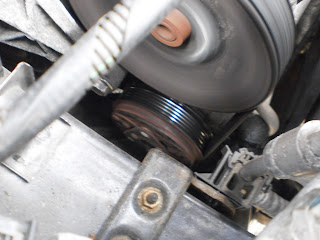Here is a 2002 Saturn L300 with 78,865 miles on it. The complaint here is no air conditioner compressor operation. The shop already did some testing and came up empty. They needed answers fast. I start the car and turn on the air conditioning. I do not hear the click of the AC compressor turning on. At this point I break out the Tech2 knowing full well that the AC compressor control is PCM controlled. Here is some data that I captured.
So here is the data capture. I am really only interested in 3 items at this point.
Here they are. From these 3 pids I can determine the following; It has or thinks it has freon, the PCM is allowing AC operation, and the PCM wants to turn on the AC relay that controls clutch operation on the AC compressor. So now I can concentrate on checking the "muscle" of the system because the "brains" seem to be working properly.
Looking at the actual AC compressor. The compressor clutch looks a bit worn and rusty. At this point I would like to get an available voltage reading at the clutch. Unfortunately, due to the placement in the vehicle I will have to go downstream to get my readings.
Here, I have the compressor clutch power and ground backprobed at the most accesible area closest to the actual compressor. Well, we need to investigate the wiring a bit more. After doing a voltage drop on the ground side of the circuit, I know that our issues are with the power side. Time to get out and review a wiring diagram.
Ok, here we go. We have the typical GM compressor control circuit. The main players are the 10amp A/C fuse and the A/C relay. I didn't go after the control side of the relay because there were no circuit codes that typically set when the control side of the relay is not intact. So let's get to the underhood fusebox.
Checking the A/C fuse and low and behold it was blown. This is going to be easy. Inserting a fresh fuse and it immediately blows when the compressor is supposed to engage. Alright, I was suspicious of the ac compressor clutch all along. So I reach underneath and disconnect the connector right at the compressor clutch and try a fresh fuse and guess what it blows as well. Now, I am down 2 fuses. I have a rule with checking shorts. If I blow 3 fuses it is time for me to put a circuit breaker in place of the fuse. I hate having to do this. I look at the wiring harness and inspect closely. It does not appear to have any obvious damage, such as from a front end hit. My mind starts to wonder is there some type of hidden gremlin on this car and I am going to be pulling harnesses apart for the afternoon? When this happens I take a breath and go back to the wiring diagram. I try to KISS (Keep it simple stupid).
Looking back at the diagram I see there is a diode on the power side of the relay. This diode is there to suppress voltage spikes when the compressor clutch releases. One side of the diode is on the power side and the other is right to ground. I know others were in here testing before me. Could I have a biased diode? Basically, a direct short to ground. Let's test.
I remove the diode and hook up my meter leads to the diode terminals. Set the meter to diode test. The diode test will do a voltage drop test across the diode. With the meter leads one way I should see approximately a half of volt (0.50v) then reverseing the "polarity" of the leads on the diode should net us an open circuit. Let's see what we got.
Yikes! Let's reverse the leads.
Double Yikes! Basically this diode is now a direct short to ground. It is now a paperclip instead of a semiconductor. Luckily, this shop owner had a GM car that was going to the boneyard. I quickly stole the diode out of the fusebox. Let's test that one.
Ok. Let's reverse the leads.
Nice. Textbook. I install the good used ac diode. I turn on the ac and listen for that familiar click from the compressor. I hear nothing. What now? I recheck the fuse-good. Rehooking up my meter leads at the compressor clutch wires I am greeted to this.
So, I now have correct voltage feed. But, still no operation. Remember, that compressor clutch I suspected all the while.
I instruct the shop to drop the compressor. Here, is the clutch coil resistance 4.69M ohms basically an open circuit. Normal clutch coil resistance is 3.22 ohms. There is a thermal fuse incorporated in the clutch coil that will open at 417F. Once this opens up there is no going back-replacement is necessary. My guess here is the compressor clutch overheated. I think the diode failure was previous tester error. Someone got happy with the power probe. The lesson here is keep cool when there are multiple issues.















Ha Ha - paper clip!
ReplyDelete